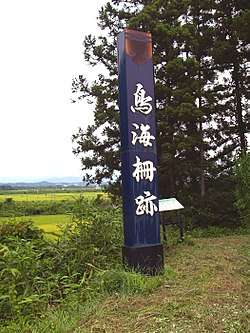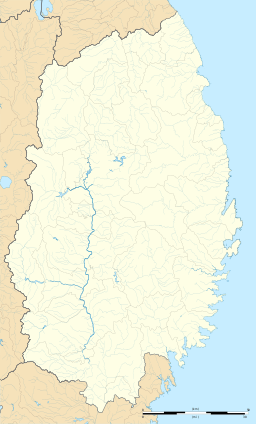Tonomi Palisade Site
| Tonomi Palisade 鳥海柵 | |
|---|---|
| Kanegasaki, Iwate Prefecture, Japan | |
 | |
 Tonomi Palisade 鳥海柵  Tonomi Palisade 鳥海柵 | |
| Coordinates | 39°36′26″N 141°10′20″E / 39.6073°N 141.1721°E |
| Type | jōsaku-style Japanese castle |
| Site information | |
| Open to the public | yes |
| Condition | ruins |
| Site history | |
| Built by | Abe no Yoritoki |
| In use | early Heian period |
| Demolished | unknown |
Tonomi Palisade (鳥海柵 Tonomi-no-saku) was an early Heian period jōsaku-style Japanese castle located in what is now the town of Kanegasaki in Isawa District, Iwate Prefecture in far northern Honshū, Japan. The site was proclaimed a National Historic Site of Japan in October 2013.[1]
Background
In the late Nara period, after the establishment of a centralized government under the Ritsuryō system, the Yamato court sent a number of military expeditions to what is now the Tōhoku region of northern Japan to bring the local Emishi tribes under its control.[2] Some Emishi tribes sided with the Yamato forces, and these allied tribes were known as Fushū (俘囚). By the early 11th century, the Abe clan, who had grown enormously wealthy by monopolizing the gold, iron and horse trade in northern Honshū, had emerged as the ruler of these fushu, and were assigned the six Emishi districts (Iwate, Hienuki, Shiwa, Isawa, Esashi and Waga) in the Kitakami Basin from Morioka to Hiraizumi in what is now Iwate Prefecture. Abe no Yoritoki constructed this stockade-fort as the Abe clan gradually came into conflict with the Minamoto clan and increased efforts towards central government control over their territories.
Description
Tonomi Palisade is located approximately 2.5 kilometers west-northwest of the conjunction of the Kitakami River and the Isawa River. It is a roughly square enclosure, approximately 500 meters north-south by 300 meters east-west, surrounded by an earthen rampart surmounted by a wooden palisade and moat. The castle was destroyed during the Former Nine Years War
Current situation
Nothing remains of Tonomi Palisade today. The Tohoku Expressway cuts through the middle of site, which is also bordered on one side by Japan National Route 4. The site has been excavated some 19 times between 1958 and 2012.
See also
References
- ↑ "鳥海柵跡 とのみのさくあと". Agency for Cultural Affairs. Retrieved 1 February 2017.
- ↑ Shively, Donald H.; McCullough, William H. (1999). Cambridge History of Japan vol. II (p.31f.). Cambridge University Press.
External links
- Kanegasaki official home page (in Japanese)